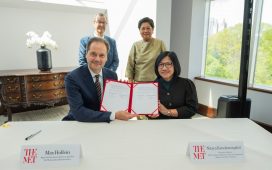Lynn Kinnear, who has died of cancer aged 64, was one of the outstanding landscape architects of her generation. Her work ranged from urban playgrounds to natural parks such as Walthamstow Wetlands in east London. She collaborated with a number of leading architects and artists, including the Richard Rogers Partnership. Burntwood school in Wandsworth, south London, which she designed with the architects Allford Hall Monaghan and Morris, won the Stirling prize in 2015. Kinnear’s overriding aim, she said, was “to work with local communities to effect change in their public space”.
Her approach combined adventurous thinking, often inspired by art, with a deep knowledge of plants and habitats. Influenced by continental European landscape designers, such as the Dutch practice West 8, she liked to play the natural off against the artificial. With her Hellings Street Park in Wapping, east London, a 1995 project that helped make her name, she created mounds and valleys out of the material used for running tracks, with a bull’s-eye pattern marked out in strong colours, and a small plantation of pine trees next to a bright blue wall. With a rope bridge and a play fort, this “lumpy landscape” was designed to encourage activity and risk-taking.
In Walthamstow she led a team that opened up a 200-hectare site, containing a group of reservoirs, to public access. The work involved nurturing and enhancing the location’s rich biodiversity, while also enabling hundreds of thousands of visitors per year to enjoy and appreciate its natural and industrial heritage. Her contribution is by turns conspicuous and barely noticeable: a long boardwalk next to a brook makes a memorable entrance into the site, where she planted willows and reedbeds that look as if they have always been there. As in much of her work, the design of the wetlands is about making the most of the inherent identity of the place.
Kinnear strove to get more out of a commission than her clients might have envisaged. “When I get a brief, it’s always a challenge to be a little outrageous,” she said. She would often devote more time to engagement with local communities than she was funded to do. With Brentford High Street in west London, where she was originally asked to design little more than an installation of lighting bollards, she redesigned the town’s Market Place as more pedestrian-friendly and active space, and made forbidding industrial sheds alongside a nearby canal more hospitable, by re-cladding them in timber fretwork. For this project, completed in 2014, she won the Landscape Institute’s president’s award.
Kinnear could be reticent about promoting her own work, but was both tenacious and pragmatic, essential qualities for getting the best of the public bureaucracies for whom she often worked. Although she had a gift for working with architects and other disciplines, she fought against a common tendency to see the design of landscape as secondary to that of buildings, and the first thing to be cut when budgets were tight. “I resist strongly,” she said, “if I’m given a project and the architecture has already been plonked on the site.”
With Burntwood school and other works, landscape and architecture are equal partners in the success of the design.
Born in Edinburgh, Lynn was the daughter of Margaret (nee Jeffcock) and George Kinnear. Her mother raised Lynn and her three younger sisters; her father worked for the city council, including as an inspector of council housing. Formative influences included her mother’s love of gardening and the keeness of her grandfather Ernest Jeffcock, a builder, for her to study architecture. She was educated at James Gillespie’s high school and studied landscape architecture at the Edinburgh College of Art, which was then affiliated to Heriot-Watt University. There she was part of a cohort taught by the exacting but inspiring Professor David Skinner, several of whom went on to be leaders of their profession.
She worked for the landscape architects Gillespies on projects including the Liverpool International Garden festival of 1984 and then for the multinational architectural practice SOM, on the Canary Wharf development in London’s docklands. While she respected the latter’s professional approach, she felt (as she later said) that it “didn’t adequately address local communities”. Keen to do her own thing, she set up Kinnear Landscape Architects in 1991.
In 1992, as a lecturer at the University of Greenwich, she helped to interview a young architect called Sean Griffiths for a part-time teaching post. Finding him arrogant, she recommended someone else, but was overruled. They became life partners, despite this unpromising start, and had a daughter, Lily, together. They also built the Blue House in east London, designed by Sean and his practice FAT , whose playful use of colour and ornament stood courageously apart from the architectural mainstream, and now makes it an object of pilgrimage to students. Completed in 2002, it remained Lynn’s home until she died.
Meanwhile her growing reputation won her a succession of projects. She designed, with the artist Richard Wentworth, a new civic square in Walsall, in the West Midlands, next to the New Art Gallery by the architects Caruso St John. The investment in education under Tony Blair’s government gave her the opportunity to design several schools. Design for London, an agency set up under Ken Livingstone after he was elected mayor of London in 2000, enabled her to work on several of the capital’s neglected green spaces. As well as designing individual projects, she also carried out strategic work, for example on the downlands in south London.
Despite the protracted and punishing treatment of her cancer, which was diagnosed in 2017, she continued the work of her practice until 2023, when she decided to close it. She and Griffiths separated in 2008, but remained on good terms, and he helped care for her during her illness, alongside other friends and family.
She is survived by Lily and by her sisters, Jo, Susie and Sally.








